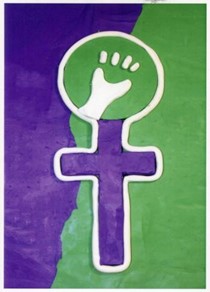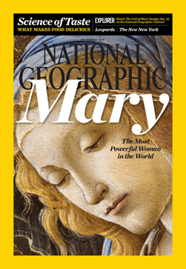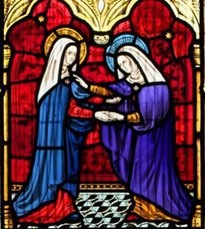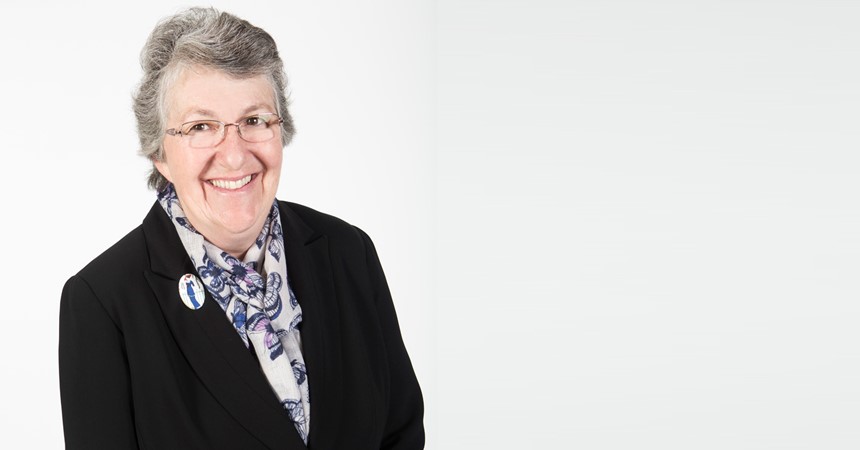Even though I write my message on a Sunday evening, some of you will be reading this on 8th March, International Women’s Day (IWD). This year’s theme is Pledge for Parity. Each year women from across the diocese celebrate Mass for this day at the Cathedral and then enjoy morning tea before listening to some women recall part of their story. This year we enjoyed the input of four women – Denise Ryan, Kiri Hata, Anne Ryan rsm and Helene O’Neill. Perhaps there were forty women who gathered to acknowledge International Women’s Day which has now been celebrated for more than 100 years.
My very creative sister-in-law, Coral Carter, sends me a postcard each year for IWD. She creates these wonderful cards using the colours white, purple and green. On the back of this year’s card she included an explanation of the feminist colours:
Mrs Pankhurst, leader of the militant Women’s Social and Political Union in the United Kingdom, adopted the colours white for purity in public and private life, purple for dignity, self-reverence and self-respect and green for hope and new life. Vida Goldstein was responsible for the introduction of the feminist colours into Australia. Vida was a suffragist and activist, organiser for the United Council for Women’s Suffrage and the first woman in Australia and the world to stand for election to the Senate.
 I have included a scan of this year’s card in which Coral used plasticine and a rolling pin and acknowledged her daughter Hope Moylan for her artistic insights. Coral, a poet, writer, photographer, teacher and many other wonderful things, is a beautiful woman and a great blessing to our family. While listening to the four speakers at our diocesan IWD morning, I was struck by the words from Kiri Hata, a strong Aotearoa woman, who presently works with our CatholicCare Refugee Service, advocating for many of those who come for assistance. She said, “When you reach the women, your reach the whole of society.”
I have included a scan of this year’s card in which Coral used plasticine and a rolling pin and acknowledged her daughter Hope Moylan for her artistic insights. Coral, a poet, writer, photographer, teacher and many other wonderful things, is a beautiful woman and a great blessing to our family. While listening to the four speakers at our diocesan IWD morning, I was struck by the words from Kiri Hata, a strong Aotearoa woman, who presently works with our CatholicCare Refugee Service, advocating for many of those who come for assistance. She said, “When you reach the women, your reach the whole of society.”
I would like to just alter it slightly to say, that when you reach the women, your reach the tribe or the village. It is then, through women, that change becomes possible. Each of the women speakers seemed to choose change as the underlying theme for their story sharing. As I looked at them, seated in the Toohey Room in the diocesan offices, I could not help but notice the stained-glass window of Mary, while recognising that we were seated in the space that was once the chapel of the Sisters of Mercy. These Mercy women surely influenced the lives of the many children and young women they taught, including me. Near this window in the Toohey Room is our very large diocesan World Youth Day Cross, and once again my mind turned to the very special relationship between Mary and her son Jesus. In my present state, I frequently find myself imaging Mary, the mother, positioned at the foot of the Cross and weeping inconsolably with the other women.
I remembered the message I had scribed just before Christmas which was about Mary, and so I now share with you some of that insight. The context for this particular reflection came about on Sunday 20th December while I was sitting in the car outside the Cathedral. Allen and I attend the 5.00pm Mass, where Allen takes responsibility for setting up and serving and I sing in the choir. We arrive at the Cathedral at 4.00pm for Allen to begin his tasks and I go in at 4.30pm for choir practice. Usually I stay in the car, and in this spare half an hour, I read and sometimes doze. On this particular day we had picked up our mail which contained Christmas cards, some other mail and the December National Geographic. Allen has subscribed to National Geographic for over forty years and yet I have rarely opened these publications. However on that particular day I opened the envelope and discovered the title; “Mary – The Most Powerful Woman in the World,” accompanied by an image of her. On the page from Susan Goldberg, the editor, she writes about “Hail Mary” – A Global Icon. She says:
The genesis of this month’s cover story dates to a year ago, when an exhibition opened at the National Museum of Women in the Arts. “Picturing Mary: Woman, Mother, Idea” brought together 74 artworks from the 14th through the 19th centuries, lent by galleries including the Uffizi Gallery in Florence, the Louvre in Paris, and the Vatican Museums.
The exhibition drew the largest crowd ever for the Washington, D.C., museum. That got us wondering: What is it about Mary? She is the world’s most  depicted woman, yet among the most mysterious, with more written about her in the Koran than in the Bible.
depicted woman, yet among the most mysterious, with more written about her in the Koran than in the Bible.
Her powers are invoked for anything and everything: by the sick in search of a cure and quarterbacks hoping for a Hail Mary pass to win the game; by mothers who feel a special kinship with her, and truckers – dashboards adorned with plastic Mary statuettes – seeking safe travels.
We wanted to understand why people from disparate cultures and places – Poland, Mexico, France, Rwanda, Egypt – share little but a belief that Mary stands up for them, approves of them, and watches out for them. So we sent writer Maureen Orth and photographer Diana Markosian to travel the globe in search of explanations and insights.
The 30 page article researched by Maureen Orth captures many images and stories of Mary across our globe. I then went to Mass at the Cathedral and of course the readings focused on Mary. In the missal which I use, the following words were written before the readings:
‘BLESSED IS SHE WHO BELIEVED.’ From Bethlehem, the least of the clans of Judah, and from a peasant girl, Mary, one of the least of the Jewish people, God prepared a body for Jesus, the saviour of the world. As we rejoice in the saviour who has come to visit us, we also join Elizabeth in praising Mary for her faith, her love and her obedience.
 Luke’s gospel picks up the story of Mary setting out with haste to visit her cousin Elizabeth and we have the wonderful image of two pregnant women greeting each other.
Luke’s gospel picks up the story of Mary setting out with haste to visit her cousin Elizabeth and we have the wonderful image of two pregnant women greeting each other.
And then I opened our parish bulletin and Ted Wolgamot writing about “True Disciple” begins with a question: “Why, out of all the women since the beginning of time, did God choose Mary to be the recipient of his most intimate of gifts? What was it about her that made her so appealing and so bewitching?” He goes on to explore Mary as a ‘being person’ rather than a ‘doing person’. He uses the following words to describe Mary:
She embraced simplicity. She experienced deep joy through being alone with the Lord in meditation. She was a contemplative……..Mary was a listener. She was perhaps one of the original believers in the value of the simple lifestyle……Be present. Be open. Be available. Be receptive. Be quiet. That’s the kind of person Mary was. And it was that collection of gifts that most likely enticed God…… Mary is the ultimate receiver of the divine in her life. She is the person, who makes room for the Spirit to dwell within her, that same Spirit who caused Elizabeth to announce with wonder, “Nothing is impossible to God”; that same Spirit who will cause each of us to become pregnant with a Child who desperately wants to “dwell among us.” It can happen, if only, like Mary, we make room.
So here is some of the message that was crafted that night, a message which was not to reach you because of the death of our grandchild Ada. Maybe the message is more suited to this particular Sunday in Lent and on the eve of IWD. It was here that I noticed the link between the wood of the cross and the wood of the crib. I was overcome with the reality that here we have a man, born to a woman, Mary, who loved him and mothered him, only to see him die on the wood of the cross.
I was disappointed that even as all the women gathered in the Cathedral to mark IWD, there was no mention of it during the homily. Over the many years of my study and formation, I have come to realise that God is not gender specific, and yet when the Word is broken open for us, the story which Jesus uses of the Prodigal Son and the forgiving father casts God as gender specific, as father. This story points to a God who is loving, compassionate, merciful, gentle, tender, forgiving and longing to see those who have alienated, return, so there can be rejoicing in the ones who were lost coming home. To me this fits the description of both a mother and a father, of family life in which both roles are critical and complementary in ‘reaching the tribe’.
In speaking with me before her sharing, Helene O’Neill told me that when people ask her what she does she often says, “Oh! I am a disciple.” I wonder if you feel like a true disciple who is forming a tribe/village? Are you listening like Mary? How are you bringing Jesus into our world?
During Mass, Bishop Bill used the Eucharistic Prayer for Reconciliation and I share with you the beginning of that prayer:
You are indeed Holy, O Lord,
and from the world’s beginning
are ceaselessly at work,
so that the human race may become holy,
just as you yourself are holy.
Look, we pray, upon your people’s offerings
and pour out on them the power of your Spirit,
that they may become the Body and Blood
of your beloved Son, Jesus Christ,
in whom we, too, are your sons and daughters.
So as we continue to prepare for our great feast of the Paschal mystery, may we continue to be courageous and bold, and to connect with some of these women ancestors in faith – Mary, Ruth, Esther, Priscilla, Elizabeth, Mary Magdalene, Rahab, Miriam, Deborah, Sarah, Hannah, Anna, Lydia, Martha, Naomi, the Samaritan woman and many others. You may also like to recall your own family and inspirational women ancestors in faith on this International Women’s Day.
Our Missionary of Mercy spent the past week at Gresford and has now moved on to Largs. Please take up the opportunity to connect with Fr Richard as he travels our diocese offering God’s merciful embrace.
I would also like to remind you that this week is Catholic Schools Week and I hope that you will take time to visit your local Catholic Schools and explore the opportunities offered by them and affirm their place in the lives of our parishes. I believe our schools need people of deep faith to step over the threshold and share that gift with their staff, students and families. Faith is caught not taught and therefore witnesses in faith are an essential element in the faith life of our schools. How blessed many of us were to be taught by many great faith-filled women in our primary school years.
Teresa Brierley

